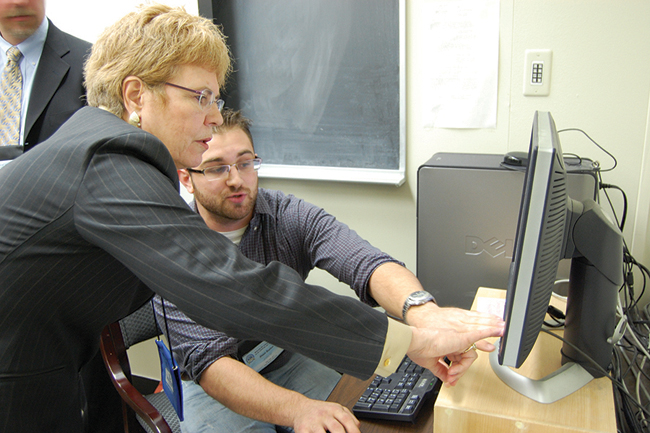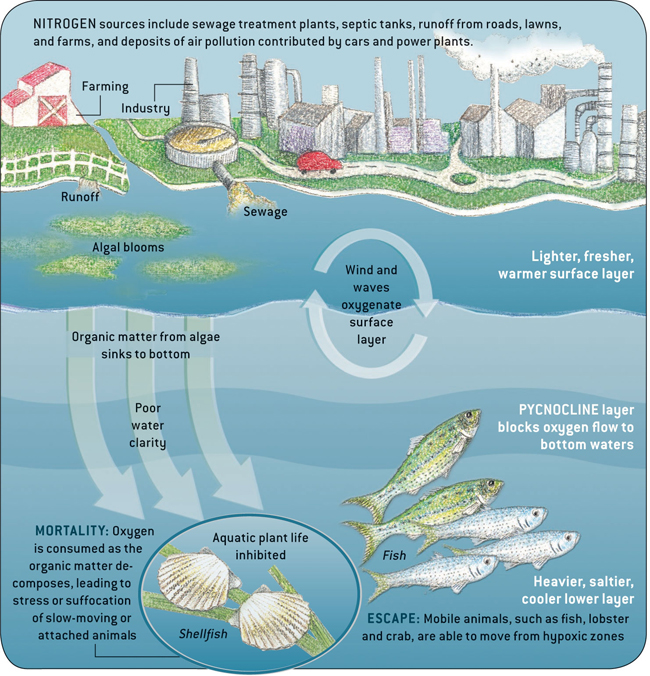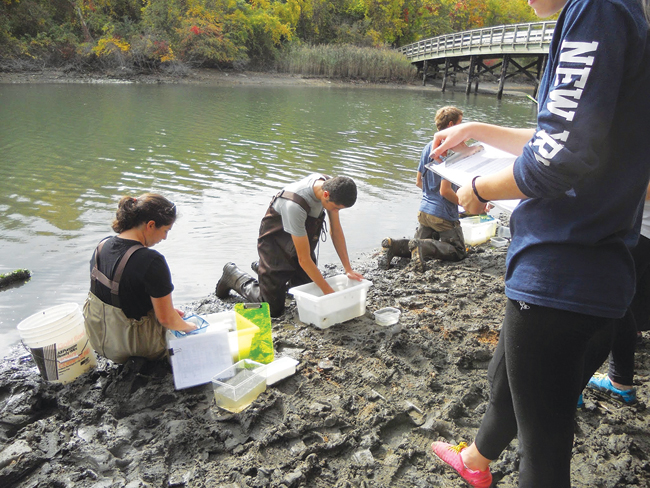
Sean Bratton, former Sea Grant Scholar discusses hypoxia with Jane Lubchenco, former Under Secretary of Commerce and administrator for NOAA. Photo by Barbara A. Branca.
NYSG’s Communications staff caught up with former Sea Grant Scholar Sean Bratton who was last seen on the pages of NY Coastlines back in 2011 during NYSG’s 40th Anniversary when former NOAA Administrator Dr. Jane Lubchenco visited Stony Brook University.
Says Sean of his experience with NY Sea Grant, “Being a Sea Grant Scholar was a tremendously rewarding experience. I received continuous support to complete my thesis and research. It was truly wonderful to work and collaborate with such a diverse and knowledgeable group of scientists. These experiences have continued to guide me in a successful career as a science teacher.”
Since leaving Stony Brook University, Sean went back to grad school for a Master of Arts in Teaching from Sacred Heart University in 2013, then moved to Chicago where he’s teaching 7th grade science at a charter, Intrinsic School, while also teaching weather-related courses as an adjunct at the College of DuPage, the second largest provider of undergraduate education in Illinois.
At Stony Brook’s School of Marine and Atmospheric Sciences, professors Brian Colle and Robert Wilson were his mentors. With them he recently published a journal article based on their collective research on Long Island Sound hypoxia: Evidence for Directional Wind Response in Controlling Inter-annual Variations in Duration and Areal Extent of Summertime Hypoxia in Western Long Island Sound.
Now that Sean has newfound expertise in communicating science, we collectively wrote a brief synopsis of the research, putting it in terms everyone can understand.

Summertime hypoxia (low-oxygen water conditions) in Long Island Sound is
correlated with local wind forcing. Winds can significantly modify
stratification different layers of water at different temperatures
within the Long Island Sound estuary. If wind mixes or churns up the
water, then there is less chance that a low-oxygen or hypoxic layer
would remain undisturbed at the bottom.
Specifically this research found that winds out of the east-northeast
are most correlated with short term (1-2 day) increases of bottom
dissolved oxygen and were termed “mixing events.” In contrast, winds out
of the south-southwest are most correlated with sustained hypoxic
conditions over western Long Island Sound.
Additionally, summertime high-pressure systems north of LIS account for a
large percentage of the aforementioned mixing events that can influence
both the duration and the extent of summertime hypoxia by producing
periods of sustained winds out of the east-northeast range.
Low dissolved oxygen levels may lead to hypoxic conditions in Long Island Sound and its tributaries, conditions detrimental to marine life. For more on hypoxia, see Long Island Sound Study's related online "status and trends" content.

Student stewards collect and analyze water samples along Sunken Meadow Creek at Sunken Meadow State Park in Kings Park, NY, a designated LIS Stewardship Area. Photo by Amy Mandelbaum, NYSG/LISS.
In the Sound Stewards program organized by NY Sea Grant’s Long Island Sound Outreach Coordinator Amy Mandelbaum, students participate in real-world research by measuring the dissolved oxygen content and other water quality parameters in designated Long Island Sound Stewardship Areas.
The data collected by Sound Stewards are used by managers at New York State Parks to determine areas of concern.
— Barbara A. Branca
More Info: Long Island Sound Study
Long Island Sound is one of the 28 nationally-designated estuaries under
the NEP, which was established by Congress in 1987 to improve the
quality of Long Island Sound and other places where rivers meet the sea.
The Long Island Sound Study, conducted under the Environmental
Protection Agency’s (EPA) National Estuary Program (NEP), is a
cooperative effort between the EPA and the states of Connecticut and New
York to restore and protect the Sound and its ecosystems.
For more on what you can do to make a difference, click over to the "Get Involved" or "Stewardship" sections of the Long Island Sound Study's Web site. News on the Long Island Sound Study can also be found in New York Sea Grant's related archives.
If you would like to receive Long Island Sound Study's newsletter, please visit their site's homepage and sign up for the "e-news/print newsletter" under the "Stay Connected" box.
For daily updates and tips on how you can help protect and restore Long Island Sound, please join LISS on Facebook, Twitter or, sign up for their RSS feeds.
More Info: New York Sea Grant
New York Sea Grant (NYSG), a cooperative program of Cornell University
and the State University of New York, is one of 33 university-based
programs under the National Sea Grant College Program (NSGCP) of the
National Oceanic and Atmospheric Administration (NOAA). The NSGCP
engages this network of the nation’s top universities in conducting
scientific research, education, training and extension projects designed
to foster science-based decisions about the use and conservation of our
aquatic resources. Through its statewide network of integrated
services, NYSG has been promoting coastal vitality, environmental
sustainability, and citizen awareness about the State’s marine and Great
Lakes resources since 1971.
New York Sea Grant maintains Great Lakes offices at SUNY Buffalo, the
Wayne County Cooperative Extension office in Newark and at SUNY Oswego.
In the State's marine waters, NYSG has offices at Stony Brook University
and Stony Brook Manhattan, in the Hudson Valley through Cooperative
Extension in Kingston and at Brooklyn College.
For updates on Sea Grant activities: www.nyseagrant.org has RSS, Facebook, Twitter, and YouTube links. NYSG also offers a free e-list sign up via www.nyseagrant.org/coastlines for its flagship publication, NY Coastlines/Currents, which is published several times a year.